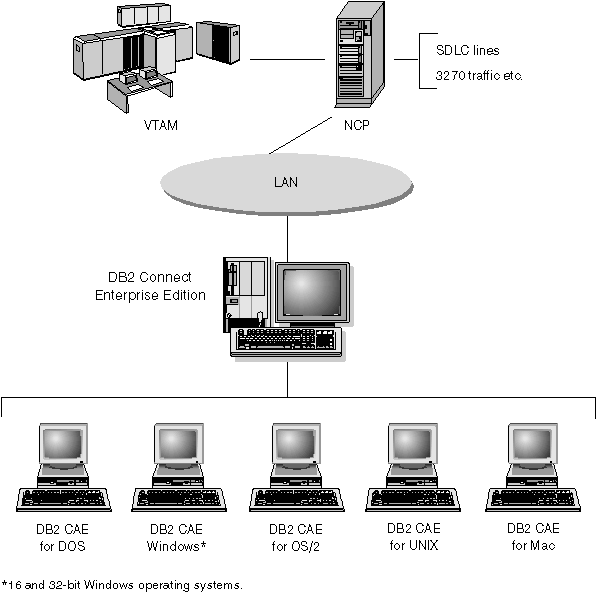

A typical network configuration might be:
Figure 9. DB2 Connect Enterprise Edition gateway SNA network scenario
 |
This scenario focuses on the throughput and response time between the host or AS/400 database server to the DB2 Connect Enterprise Edition gateway and various parameters that could affect this.
The suggested order in which to make these changes is:
1 - DELAY on PCCU macro* 2 - DLC/LLC Tuning* 3 - PIU size* 4 - Pacing window changes* 5 - DELAY on LINE macro* 6 - MAXBFRU changes 7 - LAN Frame sizes * Major improvement in throughput is possible
The RU size at the host and the DB2 Connect server should be maximized. This implies that the RU size should be large enough to contain the API crossing (both SEND and RECEIVE data for the transaction where possible) in order to minimize the number of times VTAM program stack must be traversed. Also, the network frame size may limit the maximum RU size if RU segmentation is not desired.
It is a good idea to set the DB2 Connect block size (RQRIOBLK), RU and pacing values such that RU * pacing >= RQRIOBLK. For example, the default RQRIOBLK size of 32K is a good value for most situations, and to exploit this you would set RU = 4K and receive window pacing to 8.
The session and VR pacing windows should be maximized: the largest value that does not cause network congestion or VR-held conditions, and so on, should be used. For a test environment set pacing to 0 (no pacing) or set it to the maximum value X'3F'.
Coat-tailing is controlled by the DELAY parameter. The DELAY Parameter in the PCCU macro controls outbound coat-tailing (outbound with reference to the host). The DELAY value in the LINE definition statement for the NCP controls inbound coat-tailing (inbound with reference to the host). The DELAY value determines how long a PIU is held in the queue (NCP or VTAM) before it is transmitted. The purpose of this wait is to increase the possibility that other PIUs will arrive in the interim and all of these can be transmitted on a single channel program. For the lowest latency, the DELAY value should be set to 0. Changing the value of the outbound coat-tailing delay value to 0 should have no noticeable effect on the host except for improved performance for outbound traffic. Some improvement in inbound traffic performance will also be realized. Changing the DELAY on the NCP to 0 should be done with a little more care. The value can be set to 0 if the NCP is not overloaded and the inbound traffic does not consist of a significant percentage of small frames. Setting the values of DELAY to 0 may improve response time significantly, especialy under light loads or test/benchmark environments.
VTAMB7 PCCU CUADDR=CAF,
AUTODMP=NO,
AUTOIPL=NO,
AUTOSYN=YES,
BACKUP=YES,
DELAY=0,
VFYLM=YES,
CHANCON=UNCOND,
MAXDATA=32768,
DUMPDS=NCPDUMP,
OWNER=HOSTB7,
SUBAREA=17
LNCTLS GROUP LNCTL=CA,CA=TYPE6,DELAY=0.0,TIMEOUT=500.0
CA0 LINE ADDRESS=00
PUCHAN0 PU PUTYPE=5,TGN=1
CA1 LINE ADDRESS=01
PUCHAN1 PU PUTYPE=5,TGN=1
DELAY considerations are documented in the "VTAM Network Implementation Guide".
The MAXBFRU value should be set to a value two ro three times larger than the largest PIU size.
Ensure that the LLC2 window sizes (DLC send and receive window counts) between the NCP and the DB2 Connect Enterprise Edition gateway are the same. This has a significant effect specially when the server is DB2 Connect for AIX. It is recommended that the send window count be set higher than the receive window count.
In general, for any SNA connection across a Token-ring the LLC2 timers/windows should be optimized. In some cases, this change led to a six-fold improvement in throughput and response time.
The token ring maximum frame size should be as large as possible.